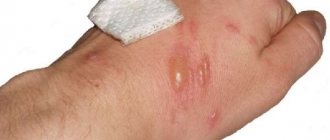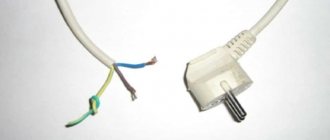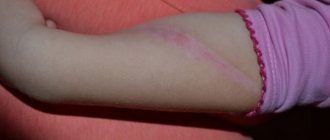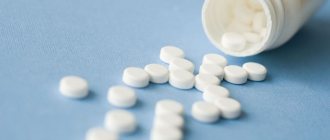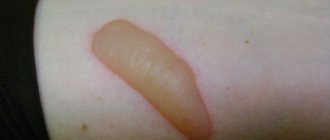A person’s life is filled with various events: pleasant or not so pleasant. One of the latter is steam burn. It is classified as thermal. Steam burns can occur at home or at work. In this case, it is very important to correctly provide first aid to the victim and determine the course of further treatment.
The article discusses the most pressing issues, namely what to do as part of first aid at home, how to relieve pain, how and how to treat a burn with steam.
What to do if you are burned by steam
Before starting treatment and providing first aid, it is necessary to assess the extent of damage and area. Next, there is a choice of method of assistance depending on the location of the lesion.
In case of skin burns, it is necessary to immediately cool the injured area. This can be done by placing the limb under a stream of cool water. If it is not possible to cool under running water, you can apply a compress or use a basin of water.
On average, the procedure takes about 20–30 minutes. It is acceptable to use pieces of ice previously wrapped in a clean textile napkin.
If the situation is complicated by the fact that tissue is stuck to the wound, then it is not recommended to tear it off. It’s better to carefully cut off the excess, and under running water it will most likely come off on its own.
Next, the wound is treated with an antiseptic. “Soft” solutions are suitable for this:
- chlorhexidine;
- miramistin.
Attention! Hydrogen peroxide, iodine or brilliant green are not recommended, as they can only worsen the situation.
For a speedy recovery, the burn is treated with Panthenol cream, Rescuer or Bepanten. If severe pain occurs, you can treat it with an anesthetic, and painkillers are taken orally.
The bandage should be loose and not compress.
To prevent harmful microorganisms from entering the affected area, apply a sterile anti-burn dressing or gauze. However, it should be free and not squeeze.
If the mucous membranes are burned, the injured area is immediately cooled, and the victim is sent to the hospital as soon as possible.
Treatment of burns at home (I and II degree)
To treat I-II degree burns, both folk remedies and medications are used.
ethnoscience
Pumpkin ointment
Pumpkin ointment has analgesic, anti-inflammatory, drying, wound-healing and antiseptic properties.
To prepare a useful product, take a ripe pumpkin, peel and seed it, and grind it using a blender, meat grinder or grater. We put pumpkin puree on a piece of bandage, apply it to the burn, and fix it with a plaster. After 2 hours, remove the bandage and apply a new one. We do this 2-3 times a day.
pumpkin juice
When a burn occurs, the question often arises: “How to relieve pain?” “Very simple,” answer admirers of traditional medicine. You just need to make pumpkin juice.
Take a ripe pumpkin, peel it and remove seeds, squeeze out the juice using a grater, meat grinder, blender or juicer. Cut off a piece of bandage, dip it in juice, and lubricate the wound. We repeat the procedure 3 times a day.
Cabbage-egg ointment
Cabbage and egg ointment is known for its restorative, nourishing, anti-inflammatory, analgesic, and antimicrobial properties.
To prepare a miraculous balm, we arm ourselves with:
- cabbage leaf – 1 pc.;
- egg white – ½ pc.
Using a blender or grater, turn the cabbage leaf into puree. In a separate container, using a mixer, beat the egg whites until thick foam. Combine the ingredients and mix well. Apply the mixture to a piece of bandage, apply it to the skin, and fix it with a bandage. After 1–2 hours, remove the bandage and apply a new one. We repeat the procedure 3 times a day.
Cocktail made from soda and curdled milk
Soda and yogurt are a duet that relieves swelling, redness, itching and pain.
To prepare a cocktail, we stock up on:
- baking soda - 1 tbsp. l.;
- homemade curdled milk - 2 tbsp.
Pour yogurt into a container, add soda and whisk the mixture thoroughly. Take a piece of bandage, dip it in a cocktail, apply it to the skin, and secure it with a band-aid. Remove the bandage after 12 hours. We repeat the procedure one more time, after which we notice that there is no trace of the burn left on the skin.
Oak Elixir
The bark has anti-inflammatory, soothing, protective, wound-healing, antiseptic, nourishing, drying and analgesic properties.
To prepare oak decoction we arm ourselves with:
- crushed oak bark - 3 tbsp. l.;
- water – 1 l.
Place the bark in a saucepan, add water and mix the ingredients. Place the container on the stove, cover the container with a lid and cook the potion for 10 minutes. Remove the pan from the stove, wrap it in a towel and wait another 30 minutes. And then filter the broth through cheesecloth. We rinse the damaged skin with the potion and make lotions.
What else can I use to anoint the wound? You can also use:
- carrots (chopped on a grater);
- applesauce;
- lingonberry pulp;
- rowan juice;
- homemade cottage cheese;
- potato starch;
- raw potatoes (chopped on a grater);
- brine;
- chicken, goose and quail eggs;
- green and black tea;
- aloe juice;
- sea buckthorn oil;
- St. John's wort oil;
- tincture of calendula, elm, aspen;
- gruel from burdock leaves;
- plantain leaves;
- fresh blueberries;
- honey.
Remember, you need to be treated wisely, having first studied the properties of a particular product. In addition, use folk remedies only for closed wounds.
Medications
If for some reason you do not want to use traditional medicine, use pharmaceutical substances. Doctors advise purchasing the following medications:
- "Panthenol", known for its analgesic and restorative effect;
- "Ricinol", which has antiseptic, regenerating, analgesic, cleansing, anti-inflammatory properties;
- “Silcoseryl”, which has a drying, antiseptic, regenerating, nourishing, wound-healing effect;
- "Olazol", demonstrating analgesic, antimicrobial, anti-inflammatory, antiseptic, restorative properties;
- gel wipes, known for their cooling, analgesic and antimicrobial properties;
- "Furaplast", which has an antimicrobial and healing effect;
- "Bepanten", which has cooling, antiseptic and analgesic properties;
- “Rescuer”, demonstrating antibacterial, nutritional and regenerating effects;
- "Actovegin", known for its analgesic and stimulating properties;
- "Chlorhexidine", which has excellent antiseptic and antimicrobial properties.
Of course, there are other drugs. Therefore, each person can choose the remedy that is most acceptable to him.
Timely and competent first aid, plus proper treatment of a burn, is the key to a quick recovery. That's all. I hope it was informative. There will be even more useful information further. And in order not to miss it, I advise you to subscribe to blog updates. See you, come again!
Wisdom Quote: He who does nothing never makes mistakes (Theodore Roosevelt).
What is strictly forbidden to do in case of steam burns?
If you have received a thermal burn from steam, there are some actions that you should absolutely not do:
- do not tear off your clothes;
- do not touch the wound with dirty hands;
- it is unacceptable to cool under ice water;
- do not puncture the resulting blisters;
- do not treat burns with solutions that contain alcohol;
- Do not apply oil or fat-containing components to the wound;
- The bandage should be loose and not compress.
All these manipulations will only cause additional damage to health, prolong the recovery period and increase pain.
Principles for assessing burn severity
When assessing the extent of damage, the following factors are taken into account:
- the severity of the wound, namely how deeply the soft tissue is affected and whether the bones are affected;
- affected area;
- area of the burned area.
If everything is more or less clear with the first two points, then how to determine the area? To do this, you need to resort to the simple rule of the palm.
The size of the hand corresponds to 1% of the total area of the skin. Just add up the number of plots.
The rule of nines can greatly simplify the counting process:
- chest and back – 18% each;
- legs – 36% (18% each);
- head and neck – 9%;
- hands – 18% (9% each).
Classification of degrees of steam burns
In total, there are 4 degrees of severity of burns received by steam. Each has its own symptoms that affect the speed of recovery. Of these, the fourth is the strongest. It causes severe damage to soft tissues down to the bones. If the affected area is large, then death is possible.
1st degree
The first is characterized by minor damage to the upper layers of the epidermis. The injured area turns red and slight swelling may appear. The victim feels a burning sensation, but there is no severe pain. Such injuries go away quite quickly, and treatment can be carried out at home . Healing time does not exceed 3–5 days. A dry film forms on the injured area and peels off. There will be renewed healthy skin underneath.
2nd degree
In the second, not only the upper layers are affected, but also soft tissues. Blisters with exudate (clear liquid) may appear. It is prohibited to open them yourself. This can only be done by a trauma department surgeon. Otherwise, pathogenic microbes may enter the open wound, which will aggravate the patient’s condition.
3rd degree
The third degree is characterized by soft tissue necrosis. Purulent contents form inside the blister, which causes severe pain. A dry crust forms on the surface. It should be noted that the skin in the affected area is not restored.
Scars appear in this area. The fact is that steam affects the subcutaneous fatty tissue, as well as the layer of new growing cells that die.
Child's burn
Children, no less often than adults, receive household injuries, including iron burns. As soon as the parent is distracted for a second, the curious kid is already climbing to check “where this steam is coming from.” As a result, the child may be injured, not only by a burn from the iron on his hand, but also on other parts of the body.
The situation is complicated by the fact that a child’s skin is even more delicate and thin than that of an adult, which means that even the slightest damage can take much longer to heal.
If you have any suspicions that your baby has been seriously injured, be sure to consult a doctor and stock up on La Cree cream, which is perfect for children’s sensitive skin. Unlike many similar skin treatment products, all La-Cri products have a non-hormonal composition with natural ingredients. Therefore, they can be used even for infants.
And, of course, remember that the best protection is prevention. When working with the iron, follow safety precautions, do not leave the device turned on unattended, and place it out of the reach of children.
First aid
First aid for a burn victim at home consists of strictly following each point of the algorithm:
- Eliminate the source of the steam and move the victim away.
- The affected area of skin is freed from clothing. It is carefully removed or cut. If the fabric is stuck, then leave this place.
- If you receive a steam burn on your arm or leg, place the area under running cool water. Its temperature should not be lower than 15 degrees. If such manipulation is difficult, then apply a damp, cool towel or a piece of ice wrapped in thick cloth.
- Rinse the wound under running water and carefully remove any remaining tissue if possible. Examine the burn. If blisters do not form, you can treat them with anti-burn agents. If they appear, first treat the area with an antiseptic.
- If steam gets on the mucous membranes, you must call an ambulance. Cool the affected areas while you wait. If the mucous membranes of the mouth and pharynx are injured, drinking plenty of fluids is recommended. If hot steam gets into the eyes, the eyelids are most likely to be damaged, since the eyes close reflexively. In any case, it is recommended to wash your face with cool water and apply a cooling bandage.
- The next step is to treat the wound with an antiseptic solution and, provided there are no blisters, apply anti-burn ointment.
Attention! For grade 2 or higher, it is recommended to contact the nearest medical facility to determine the progress of burn treatment and hospitalization if necessary.
How to relieve pain
The further spread of the burn depends on how quickly the victim cools the affected area of skin. In addition, a stream of cool water will relieve the burning sensation and pain. However, the discomfort may soon return again.
If blisters do not form, then an anti-burn agent is applied to the wound. Some products contain anesthetics.
For severe pain, it is recommended to take a pain reliever to which there is no allergic reaction. Otherwise, your health may deteriorate significantly, leading to painful shock.
If there are no medications at hand, then you can resort to traditional medicine methods. Recipes have been collected for centuries and you can choose the right one, from cabbage leaves to herbal infusions.
When to call a doctor
Even household use of hot oil can lead to disastrous consequences. Doctor's help is necessary in the following cases:
- A child was injured. Children's skin regenerates faster, however, the pain experienced by a baby, especially one who cannot talk about it, is terrible. Panic and chaotic actions will not add any benefit.
- Mucous membranes are affected. Eyes, mouth, throat, genitals.
- The burn area is larger than the victim's palm.
- Pregnancy. The leading physician must assess the potential danger to the mother and fetus.
- The advanced age of the victim.
Timely first aid and the participation of a specialist are the key to successful healing of a burn from boiling oil.
First aid kits with the required medications must be available at production facilities. Timely replenishment is the responsibility of the manager. This article is for informational purposes only, please consult your doctor for details!
Treatment
After providing first aid for a burn, it is necessary to begin recovery and treatment. You can use methods of traditional and ancient recipes of alternative medicine.
Folk recipes
Such methods do not lose their relevance even with the active development of pharmaceuticals. Finding yourself at home alone with trouble or far from pharmacies, you can resort to the recipes of your grandparents, who saved you in the old days.
- Egg white , easily whipped into a stiff foam, will relieve pain and speed up the process of cell regeneration.
- Raw root vegetables, namely potatoes and carrots in a 1:1 ratio. The resulting pulp is applied to the wound in the form of a compress and changed periodically. You can add half a teaspoon of honey as an antiseptic.
- Aloe. You can use the juice of this plant and lubricate the wound, or grind the leaf to a mushy state and make a loose bandage with a medicinal compress.
- Softened cabbage leaf or plantain is applied for 10 minutes and changed periodically.
However, you should not get carried away with self-medication methods. Visit your doctor as soon as possible and buy medications.
Pharmaceuticals
Every day, pharmaceutical scientists work and make the latest inventions designed to relieve pain and speed up the recovery process after an injury. Today there are several effective drugs:
- Panthenol , which contains dexpanthenol, which accelerates the regeneration process, as well as pain-relieving components. The anti-burn agent is available in the form of a spray, which facilitates the application process.
- Bepanten-plus cream . This is an ointment for steam burns. The cream is made on the basis of dexpanthenol. In addition to accelerating the healing process, it has disinfectant properties.
- Olazol spray includes Levometicin - an antibiotic, Anestezin for local anesthesia, sea buckthorn oil for wound healing. This anti-inflammatory drug is often used in the treatment of thermal burns of 3 and 4 degrees of severity.
- To treat the mucous membrane of the eye, the ophthalmologist may prescribe Levomycetin or Albucid drops.
- Radevit and Levomekol - budget funds that accelerate recovery
Also, one should not neglect the doctor’s prescriptions, because he prescribes medications that are selected based on the complexity of the injury.
Folk remedies
In the arsenal of traditional medicine there are many “grandmother’s” recipes regarding the treatment of burns with an iron. Some of them are not recognized by modern medicine: for example, as mentioned earlier, a burn should not be smeared with sour cream (some do it the “old fashioned way”). The same applies to urine lotions (toxins contained in urine can lead to inflammation, so it is better to refrain from this method).
If you are going to turn to folk remedies, use neutral and safe tips:
- You can apply aloe pulp to the burn site (the leaf is peeled and finely ground). This plant is non-toxic, has good penetrating properties and helps reduce pain.
- You can wash damaged skin with a decoction of linden blossom (the plant is brewed in water in a ratio of 1:10).
- You can apply a cold cabbage leaf to the damaged area - it will cool the skin and reduce inflammation.
- A healing decoction of St. John's wort, calendula, chamomile, nettle and yarrow helps well: 1 teaspoon of each plant is brewed in 2 cups of boiling water, left for 10 hours and the burn is washed with the solution.
- You can apply a compress - a bandage dipped in a soda solution - to the damaged area. Its alkaline composition neutralizes the acidic environment formed on the surface of thermally exposed skin, which means it reduces the risk of burn inflammation.
- It is believed that toothpaste with menthol can reduce the pain from a burn: apply a thin layer to the damaged skin and hold for a while.
When to call an ambulance
It is necessary to call an ambulance if a pregnant woman, child or elderly person is injured. Painful shock can negatively affect the general condition of the victim, and some medications may be prohibited for expectant mothers and children.
Burns of mucous membranes are dangerous due to their consequences. Steam that gets into the mouth, throat, or nose can penetrate deeper into the respiratory tract and cause complications.
If the face or eyes are affected, vision may deteriorate. If the groin area is damaged, the help of specialized doctors will also be required.
First-degree burns, occupying more than 10% of the total skin area, 2nd degree of severity and higher require treatment in a hospital setting and constant monitoring by doctors.
Possible consequences
When burned by steam, some of the epidermal cells die. Redness is a consequence of poor circulation. And the nerve cells that were also affected will remind you of the burn for some time.
If blisters have formed on the surface, it is recommended to entrust their opening to an experienced surgeon. If you pierce yourself, there is a risk of infection on the unprotected layer. This may cause suppuration. The same consequence awaits a patient who ignores the rules for treating an open wound.
Even after the wound heals, marks remain on the body. In case of first-degree burns, peeling of the skin causes itching and irritation, but after some time the skin is completely restored, without leaving a single trace. With more severe injuries, unsightly scars and scars remain on the skin.
Note! Injuries to the eyes, respiratory tract and groin area are especially dangerous. If the eyes and eyelids are affected, the victim may experience decreased visual acuity, tearing, fear of bright light, and clouding of the cornea.
When steam enters the respiratory organs, the latter begin to actively contract. This phenomenon can be called reflex. The body involuntarily “pushes” the pest out of itself. Thanks to this, the risk of severe injury is minimized. However, it is recommended to monitor the patient's condition over the next 10–12 hours. If the damage was severe, then pulmonary edema or pneumonia may develop.
Expert opinion
The conducted clinical study proves the high efficiency, safety and tolerability of products for daily skin care of children with mild and moderate forms of atopic dermatitis and during remission, accompanied by a decrease in the quality of life of patients. As a result of therapy, a decrease in the activity of the inflammatory process, a decrease in dryness, itching and flaking was noted.
The properties of the cream for sensitive skin are confirmed by clinical research. This tool:
- reduces itching and irritation;
- relieves skin redness;
- moisturizes and gently cares for the skin.
Sources:
- Fundamentals of health development in children. Textbook. — Moscow: Mir, 2016. — 384 p. Tulchinskaya, V.D. Nursing assistance to children / V.D. Tulchinskaya. - Moscow: Russian State University for the Humanities, 2016. - 368 p.
- Andropova T.V., Gudina M.V., Odintsova I.N., Hygiene of children and adolescents, publishing house: Siberian State Medical University Publishing House, 2022 - 101 p.
- Kovyazina N.A., Fedosimova N.A., Illek Ya. Yu. Diagnosis of atopic dermatitis in young children, Vyatka Medical Bulletin, 2007
- Smirnova G.I. Managing the course of the disease: atopic dermatitis in children, Russian pediatric journal, 2014
